Book reviews, Summer 2012
EAST MIDLANDS HERITAGE: AN UPDATED RESEARCH AGENDA AND STRATEGY FOR THE HISTORIC ENVIRONMENT OF THE EAST MIDLANDS
David Knight, Blaise Vyner and Carol Allen: Nottingham Archaeological Monographs 6, York Archaeological Trust and the University of Nottingham; 2012.
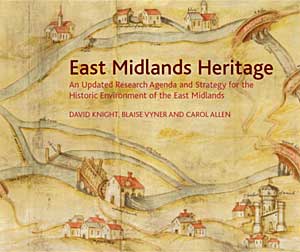
This volume which was compiled on behalf of the region’s historic environment community, represents the final stage for the East Midlands of the Regional Research Framework Initiative proposed in the 1996 English Heritage publication Frameworks for Our Past (Olivier, A, 1996). It builds upon the Archaeological Resource Assessment and Research Agenda presented in The Archaeology of the East Midlands (Cooper, N. (ed.), 2006, The Archaeology of the East Midlands: An Archaeological Resource Assessment and Research Agenda), and provides a framework for research across Derbyshire, Leicestershire, Lincolnshire, Northamptonshire, Nottinghamshire and Rutland.
Aims
The Strategy is intended as a resource for everyone with an interest in the archaeological and built environment resource of the East Midlands. It should not be regarded as prescriptive, but rather as a distillation of current views on research priorities and a tool for facilitating applications for research funds. The Strategy also seeks to assist curators, developers, archaeological contractors and consultants in the preparation of schemes mitigating the heritage impact of development, and hence complements planning guidance documents.
Developing the Strategy
The project was funded by English Heritage and has been guided by a Steering Group with members drawn from across the East Midlands historic environment spectrum. The project has also benefitted from the input of an advisory panel of period and subject specialists who, from the Nottinghamshire perspective, have advised on topics as diverse as hunter-gatherer activity at Cresswell Crags, Iron Age and Roman rural settlement, the origins and development of the Medieval open-field system and the morphology and use of Nottingham’s caves. Beyond this, we have sought to consult widely with stakeholders across the region with the aims of integrating more closely archaeology and the built environment and of fostering closer links between heritage bodies. We have liaised extensively with individuals and organisations with interests in the historic environment, including developers, consultants and voluntary bodies, together with archaeologists and building specialists from the academic, contracting, curatorial and museum sectors. Representatives of other national and regional organisations, including English Heritage, the National Trust, Natural England and the Environment Agency, have also been widely consulted. We currently have a contact list of over 800 consultees that continues to grow as additional organisations and individuals with a strong stake in the regional heritage are identified.
Presenting the Strategy
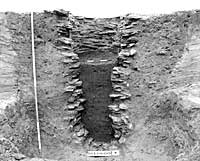
Langford, Nottinghamshire: the river terraces and floodplain of the Trent Valley preserve a remarkable wealth of evidence for the Romano-British settlement, as exemplified by this stone-lined well with a humanic silty fill containing animal bone and leather. The original cut for the well through river sands is clearly visible either side of the stone lining. (Photo: Lee Elliott, Trent & Peak Archaeology. Original in colour).
Attention is focused in the first chapters of the Strategy upon the essential building blocks of research, without which the research strategies recommended in that work cannot easily be implemented. Following this, we present a series of tables aimed at summarizing succinctly, by period, the agenda themes and topics identified by consultation and the strategies recommended for addressing these. Many of the general themes identified in the period syntheses, such as the development of the agricultural economy or the growth of towns, overlap period boundaries. These are brought together in a final section, which identifies a number of overarching research themes to which East Midlands sites can make an especially significant contribution.
Publication and Website
A free copy of the Agenda and Strategy may be obtained from Christine Kyriacou at York Archaeology Trust (ckyriacou@yorkat.co.uk), while a digital version of this publication may be downloaded from the Trent & Peak Archaeology website. Details of public seminars, workshops and other documents produced during consultation, information on stakeholder conferences and details of forthcoming events aimed at advancing the strategy may also be obtained from the TPA website.
The future
The Agenda and Strategy are seen as living documents which will evolve as research objectives are met and as priorities change, and we anticipate regular revisions of Agenda topics and Research Objectives. The Strategy will be reviewed annually by the Steering Group, initially over a five-year period, while progress on the Research Objectives defined in this document will be assessed and priorities revised where appropriate. We welcome on-going input from stakeholders, who we hope will communicate with the project Steering Group via the project website.
The next key event is a conference to mark the publication of the Agenda and Strategy. The conference will be held at the Derby Roundhouse on Saturday, 15 September and will include a wide range of presentations focusing upon research spanning the Palaeolithic to Modern periods. A full programme, together with booking form and details of location, access and parking, can be obtained from the Trent & Peak website.
FOLLOWING THE FOSSE WAY THROUGH NOTTINGHAMSHIRE – ARCHAEOLOGY AND THE A46 – Cotswold Wessex Archaeology for the Highways Agency, 2012
A46 NEWARK TO WIDMERPOOL IMPROVEMENT SCHEME – Balfour Beatty Civil Engineering, 2012.
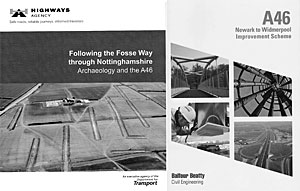
Two booklets, the first of 12 pages and the second of 31 pages in softback.
The first deals briefly with the archaeological work and finds undertaken by Cotswold Wessex Archaeology and is written by Phil Andrews and the well known from Time Team, Phil Harding. The booklet is very well illustrated with colour photographs, maps, drawings and diagrams. It starts by outlining the project and the archaeological programme (which started as early as the 1990s). Over 60 archaeologists were involved in the work.
The booklet explains the context of the finds and traces them from the Hunter Gatherer peoples of the area and follows developments to the Anglo-Saxon period and later. It is essential intended for the lay-man, is not in any way academic in style, but is presented in a manner which anyone can pick-up and read through even without more than a casual interest in the subject matter.
The second booklet is an out-and-out publicity product for the main construction contractor, Balfour Beatty. Nevertheless, it has a plethora of colour pictures, plans and maps to give an interesting overview of the construction of what is stated to be Britain’s Best Built Road. The planning history of the project is explained and there is an interesting page of key facts and figures amongst which are stated to be that over 8,000 design drawings were produced for the work, ecological considerations were high in the planning processes, at peak times up to 720 people were working on site and, since Summer 2010, no waste was sent to landfill.
Together these two booklets provide a most interesting insight into the A46 work from initial planning to completion and increase understanding of the requirements of major infrastructure projects.
Sadly, neither is now available in hard format but the archaeological one can be found as a PDF on the Highways Agency web site at: www.highways.gov.uk/roads/projects/4406.aspx
WILLOUGHBY BY NORWELL DESERTED VILLAGE, Norwell Parish Heritage Group, 2012.
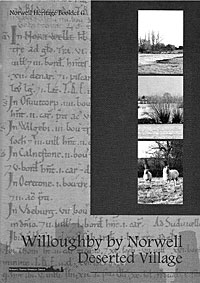
This booklet of 56 pages plus glossary and index is No. 6 in the Norwell Heritage Booklet series and maintains the very high standards of the previous 5 products. It is softback, printed on high quality gloss paper which sets off the numerous illustrations, plans and diagrams extremely well. As with the previous booklets in the series it sets a standard to be aimed at by all Local History societies and groups in their publication quality.
Thoroton Society members have recently been fortunate enough to visit Willoughby deserted village and the site is truly fascinating; it is a scheduled ancient monument in private hands and used for grazing and hay/silage production by the landowner.
The booklet is written in an easy style which is accessible to a general reader whilst giving plenty of information for the historian. Whilst it does not use footnotes there is ample information about sources and I especially liked the frequent references in brackets to mentions elsewhere in the book relating to the particular subject being read about; this is an excellent feature. There are ‘panels’ where additional information is given which is not directly related to Willoughby, for example, about landed families.
There are many illustration, maps, diagrams and photographs although if there is a criticism, it is that some of these are rather small and so lose impact but, overall, they add to the pleasure of reading this booklet.
This is a well produced and written explanation about Willoughby and Norwell and is thoroughly recommended.
Details of the way to purchase this and the other booklets in the series are given on the Norwell Parish Heritage Group web site.
ON THE FLATS: AN ORAL HISTORY OF THE HYSON GREEN FLATS, 1965-87, Helen Bates, et al. (eds.). Nottingham 2012, ISBN 978-0-9552030-1-5. (not for sale but available through Nottingham Central Library).
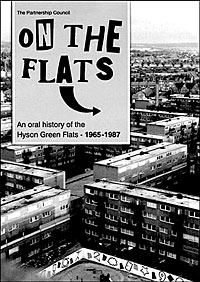
The Hyson Green flats were once notorious. In a Nationwide programme hosted by Frank Bough in the 1970s, they were depicted as hell on earth. Stories of the all-night Blues parties keeping residents permanently awake, of drink, drugs and violence, associated particularly with the underground garage area, and prostitutes queuing up for business, all made for an unsavoury reputation which culminated in the 1981 summer riots. But was it all as bad as this image suggests?
Helen Bates, with funding from the HLF, and with help from numerous volunteers, has revisited (virtually) the flats, twenty-five years after they came down, and the result is this book, with accompanying DVD of the same name, reflecting on the twenty or so years that the flats were occupied.
One of the problems with oral testimony is that we do not know how much people filter their memories. We have to ask whether those willing to take part in the project, and to be filmed for the DVD, were really remembering the flats or creating a rosy glow over an area which was certainly blighted, if not as socially dysfunctional as the media would have us believe. Many of the stories have a ring of truth: Rachel, for example, accepting her mother’s assurance that young ladies standing on street corners were waiting for ice cream vans - until she saw them there in the middle of winter and began to ask different questions! Others are less convincing - were the Blues parties really so well ‘accepted’ in the flats as is suggested here? Nationwide certainly drew an extraordinarily negative image, building on a suggestion of the then prime minister, James Callaghan, that too many poor quality high or medium rise homes had been built in the post war years. And maybe calling them maisonettes was somewhat hopeful - they soon came to be known as flats locally.
No quibbles however. This has been an excellent community history project and Helen Bates and her team have done a superb job. The DVD includes archive footage coupled with recent interviews and testimonies, all of which can be read in detail in the book. Twenty-five years on memories are inevitably fading, but Helen and her volunteers have captured them here for posterity.
John Beckett